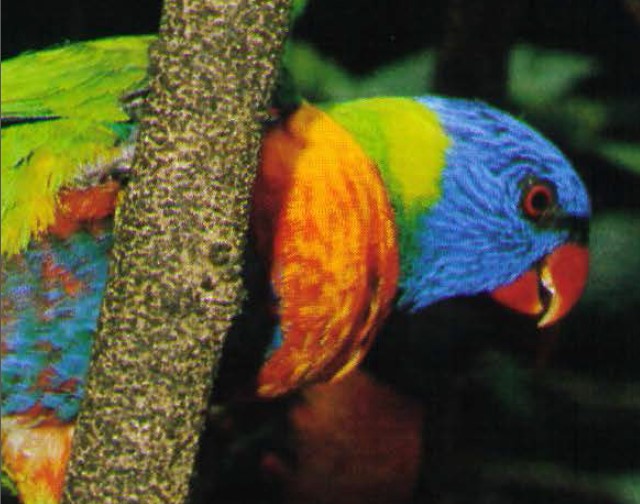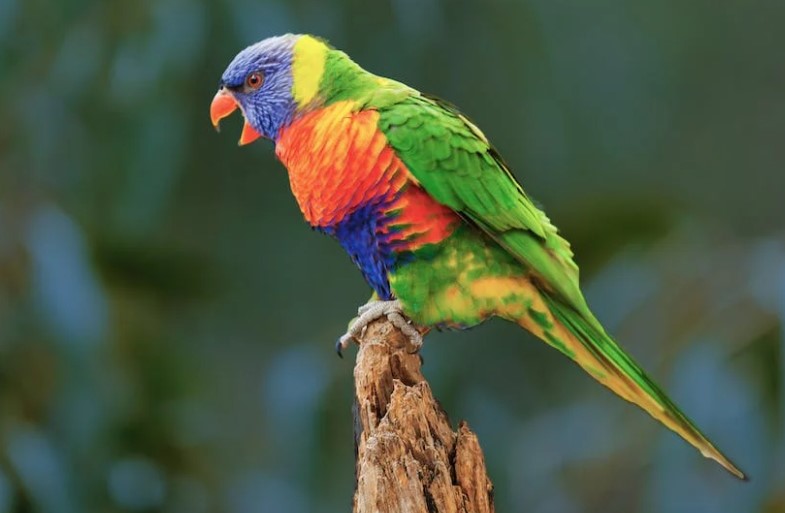First illustrated in color in Peter Brown’s Illustrations of Zoology in 1774, the rainbow lorikeet (Trichoglossus moluccanus) was the first Australian parrot to appear in the book. As a result, this gaudy parrot has become one of the most widespread of the lorikeets and has come to symbolize many of their habits and behaviors.
Among its many names are Coconut Lory, Red-collared Lorikeet, Blue-bellied Lorikeet, and Blue Mountain Lorikeet. In most cases, rainbow lorikeets are monogamous and remain paired with the same partner for a long time, if not for the rest of their lives. From eucalypts, paperbarks, and banksias to rainforest trees, palms, and grass trees (Xanthorrhoea), this blossom-feeder harvests nectar, pollen, insects, and fruit as it finds them.

This lorikeet also has brush-like papillae on its tongue, which it uses to mop up food from flowers, and a stomach with a thin wall for efficient digestion. Carbohydrate is obtained from the nectar, while protein is believed to be obtained from the pollen. In order to meet its nutritional requirements, the lorikeet only needs to be harvested for two to three hours a day.
Unlike other lorikeet species, the rainbow is arboreal and gregarious, flocking in groups of around ten to five hundred during the day to roost in clumps of several hundred. The birds disperse each morning from their roosts as the day breaks, sometimes traveling more than 50 kilometers to feed. Despite their widespread distribution, rainbow lorikeets remain fairly common. This is Australia’s most frequently observed bird, according to a survey conducted by Birdlife Australia.
They often fly close to treetops, sometimes high above, on pointed, whirring wings, screeching regularly as they maneuver like arrows in compact groups. There is no gliding involved. When they are at food trees, they often hang upside-down and rifle blossoms as they clamber through the outer leafy foliage.
A lull usually occurs during the midday heat as birds sit about and preen one another, strip leaves idly, or feed briefly. Afterward, they return to their roosts, often on the coast, on hills, or even in mangroves, after another intense feeding session. These brilliant birds congregate in hundreds at their camps, which is a spectacular sight. Several times before settling down, they dash around to repeat their performance several times as they emerge low through the trees, screeching and chattering loudly. In most cases, pairings are permanent.
Males and females play at biting when they bow, bob, and squirm close together during courtship. It appears that the female incubates alone, but the male spends a lot of time in the hollow with her, regurgitating food for her and roosting with her at night. It is common for young people to return to the nest to sleep for several days after they have fledged.
Approximately 300–320 mm in length, including the long tapering tail, are the dimensions of the Rainbow Lorikeet. There is no difference between the sexes as adults. Feather shafts are lighter than the head, which is violet-blue. There is an orange-yellow collar on the nape, followed by a greenish-yellow collar on the rest of the head, including the wings and tail. Also, a dark blue mantle is worn by the red-collared race. A bright yellow-orange color is on the breast and belly, sometimes accompanied by a faint dark blue line. A large patch of violet-blue or green-black color is visible on the belly’s center. There is a strong yellow marking on the thighs, lower flanks, and undertail coverts.
The underside of the flight feathers has a broad yellow band washed with orange. There is an orange-red color to the eyes. There is coral on the bill and reddish gray on the cere. Brown-grey is the color of the feet and toes. An immature bird has a duller color and a shorter tail than an adult. A brown eye is visible.

There are yellow markings on the bill towards the lip. Downy young have white hair and dark bills. Rainbow Lorikeets make a metallic, rolling, continuous screech in flight as their contact call. When feeding, there is a loud chattering sound. A soft Twitter can be heard during the rest of the day.
In the north, nesting has been observed in most months of the year between August and January, but this varies from region to region. Hollow limbs or holes in trees near water make good nesting sites. Two to three eggs are laid by the parrot; they are white in color, oval in shape, and measure 27–28 x 22–23 mm in size. At the bottom of the hollow, there was wood dust. The incubation period is about 25–26 days for females. The young fled after about eight weeks of being fed by both parents.
It is generally considered that rainbow lorikeets make excellent pets for people who have a lot of spare time to spend with them. The rainbow lorikeet loves to play and needs lots of toys to keep its mind and beak occupied. Aviaries or flight cages are needed for these birds. Rainbow lorikeets are affected every year by a syndrome with an uncertain etiology. Thousands of people suffer paralysis in southeast Queensland and northeast New South Wales each year, most notably being unable to fly or eat.
Rainbow Lorikeets are common in most forests and close forests of northern and eastern Australia, from Kimberley Division to Cape York Peninsula, Tasmania, and Eyre Peninsula, South Australia. Perth, Western Australia, has also been introduced to it. Locally nomadic, it is abundant; however, it is vagrant in Tasmania. It prefers lowland areas with flowering trees. It also occurs in Lesser Sundas, southern Moluccas, New Guinea, the Bismarck Archipelago, the Solomon Islands Vanuatu, and New Caledonia.

There are four races found in Australia:
-
There is the first one in the northwest, east of the Gulf of Carpentaria, with a broad yellow wing bar and a red collar.
-
The second on the Cape York Peninsula has a very bright turquoise head, a green collar, a bright blue belly, and a rather stumpy tail.
-
There is a third species throughout the eastern part of the country, from the northern areas of Cairns to eastern Victoria. It has a large body, a green collar, a blue belly, and a narrower wing bar, as well as a medium tail.
-
In the fourth race, which resides in Western Victoria and the South Australian gulfs, the tail and bill are much smaller than in the eastern race.







